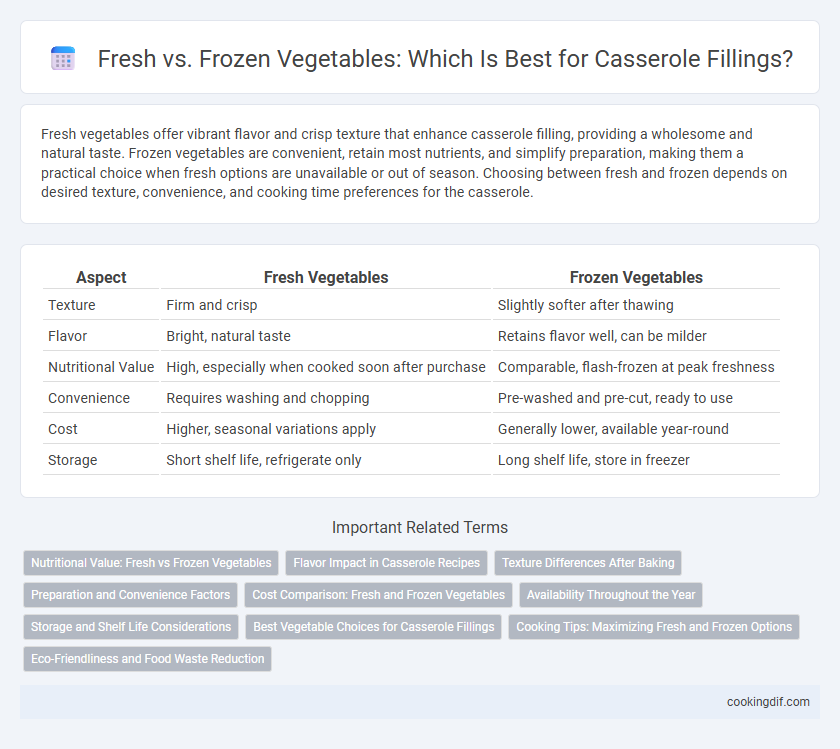Fresh vegetables offer vibrant flavor and crisp texture that enhance casserole filling, providing a wholesome and natural taste. Frozen vegetables are convenient, retain most nutrients, and simplify preparation, making them a practical choice when fresh options are unavailable or out of season. Choosing between fresh and frozen depends on desired texture, convenience, and cooking time preferences for the casserole.
Table of Comparison
| Aspect | Fresh Vegetables | Frozen Vegetables |
|---|---|---|
| Texture | Firm and crisp | Slightly softer after thawing |
| Flavor | Bright, natural taste | Retains flavor well, can be milder |
| Nutritional Value | High, especially when cooked soon after purchase | Comparable, flash-frozen at peak freshness |
| Convenience | Requires washing and chopping | Pre-washed and pre-cut, ready to use |
| Cost | Higher, seasonal variations apply | Generally lower, available year-round |
| Storage | Short shelf life, refrigerate only | Long shelf life, store in freezer |
Nutritional Value: Fresh vs Frozen Vegetables
Fresh vegetables for casserole filling often retain higher levels of vitamin C and antioxidants due to minimal processing and shorter storage times. Frozen vegetables, however, are typically flash-frozen shortly after harvest, preserving nutrients like fiber, potassium, and some B vitamins effectively. Nutritional differences depend on factors such as vegetable type and storage duration, but both fresh and frozen options contribute valuable nutrients to casseroles.
Flavor Impact in Casserole Recipes
Fresh vegetables retain their natural crispness and vibrant flavors, enhancing the overall taste and texture of casserole fillings more effectively than frozen ones. Frozen vegetables can sometimes release excess moisture during cooking, leading to a diluted flavor and a soggier casserole texture. Using fresh vegetables results in a more pronounced, rich flavor profile that elevates the dish's quality and appeal.
Texture Differences After Baking
Fresh vegetables in casserole fillings maintain a firmer texture after baking, providing a pleasant bite and distinct vegetable integrity. Frozen vegetables often release more water during cooking, resulting in a softer, sometimes mushy texture that can affect the overall consistency of the casserole. Choosing fresh or properly thawed and drained frozen vegetables impacts the final texture, influencing the dish's appeal and mouthfeel.
Preparation and Convenience Factors
Fresh vegetables for casserole filling offer superior texture and flavor but require thorough washing, peeling, and chopping, which can be time-consuming. Frozen vegetables provide convenient, pre-cut options that reduce prep time significantly and maintain nutritional value through quick freezing methods. Choosing frozen vegetables enhances meal preparation efficiency, especially for busy households seeking quick, hassle-free casseroles.
Cost Comparison: Fresh and Frozen Vegetables
Fresh vegetables for casserole filling often have a higher upfront cost due to seasonal availability and shorter shelf life, while frozen vegetables provide a cost-effective alternative with longer storage and minimal waste. Frozen vegetables retain nutritional value and offer consistent quality year-round, reducing expenses related to spoilage. Choosing frozen options can therefore enhance budget efficiency without sacrificing flavor or texture in casseroles.
Availability Throughout the Year
Fresh vegetables offer peak flavor and texture but are often limited by seasonal availability, making them less reliable year-round for casserole fillings. Frozen vegetables provide consistent quality and convenience, retaining nutrients through flash-freezing, which makes them an ideal choice regardless of season. Choosing frozen vegetables ensures casserole recipes remain accessible and vibrant, even when certain fresh produce is out of season.
Storage and Shelf Life Considerations
Fresh vegetables offer superior texture and flavor in casserole fillings but require refrigeration and typically last only 3 to 7 days before spoilage. Frozen vegetables provide convenience and extended storage, maintaining quality for up to 8 to 12 months when stored at consistent freezing temperatures around 0degF (-18degC). Proper packaging and minimizing freezer burn are essential to preserving the nutrients and texture of frozen vegetables in casseroles.
Best Vegetable Choices for Casserole Fillings
Fresh vegetables like bell peppers, zucchini, and carrots retain vibrant flavors and firm textures that enhance casserole fillings, offering a more distinct taste and appealing appearance. Frozen vegetables such as spinach, peas, and corn provide convenience and consistent quality, maintaining nutritional value while reducing prep time. Choosing vegetables with sturdy textures and balanced moisture levels ensures optimal casserole consistency and prevents soggy or watery results.
Cooking Tips: Maximizing Fresh and Frozen Options
Fresh vegetables provide vibrant flavor and texture, ideal for casseroles that benefit from a crisp bite, while frozen vegetables offer convenience and consistent quality year-round. To maximize freshness, lightly saute or roast fresh vegetables before adding them to the casserole to enhance their flavor and prevent excess moisture. For frozen vegetables, thaw and drain thoroughly to avoid sogginess, and adjust cooking time to ensure even heat distribution and optimal texture.
Eco-Friendliness and Food Waste Reduction
Fresh vegetables for casserole filling often have a lower environmental impact when sourced locally and in season, reducing transportation emissions and packaging waste. Frozen vegetables, however, offer advantages in minimizing food waste due to longer shelf life and preservation of nutrients, helping households avoid spoilage. Choosing between fresh and frozen vegetables hinges on balancing eco-friendliness with practical food waste reduction strategies.
Fresh vs Frozen vegetables for casserole filling Infographic

 cookingdif.com
cookingdif.com